Environmental Threats and Geographical Education: Students’ Sustainability Awareness—Evaluation
Abstract
:1. Introduction
- Analyzing the sustainability concepts in teaching geography;
- Comparing the most common teaching methods regarding the effectiveness;
- Indicating the difficulties in learning geography for a high school student;
- Making education policy makers as well as teachers and scientists aware of strong and weak aspects of geographical education under the aspect of sustainability;
- Proposing changes in school curricula in order to increase the awareness of sustainable development.
2. Materials and Methods
2.1. Procedure and Participation
2.1.1. Survey among Teachers
- Select the tools/methods you use in geography teaching (lecture, multimedia presentation, educational movie, educational game).
- Which of the units of physical geography discussed in geography lessons are (according to your observations) difficult and which are easy for a student? The answer should be based on the results of tests checking the scope of the student’s knowledge.
- Indicate the causes of difficulties in the effective implementation of educational units (difficult content, difficult terminology, too little time for implementation, lack of tools for the proper transfer of information, inadequate methods, no difficulties).
- What results do students get from tests covering the content of each unit?
- How many lessons do you spend on the implementation of each educational unit?
- How students perceive the attractiveness of each educational unit?
- The list below shows threats/problems in the natural environment. Which of them are the student aware of before implementing/discussing at school? (Floods, global warming, soil depletion, wildfires, water pollution, air pollution, soil pollution, desertification, ozone hole, melting of glaciers, reduction of biodiversity, intensification of extreme weather phenomena, changing the boundaries of the occurrence of plant zones, change of flora and fauna species, bad waste disposal).
2.1.2. Survey among Students
2.1.3. Analysis
3. Results and Discussion
4. Summary and Conclusions
- Students have the least information about issues related to the pedosphere (soil depletion and pollution, reduction of biodiversity). This topic—Soils and biosphere—is perceived as the most unattractive for them to study, even during and after implementation.
- Students are not aware of the role that soil plays in human life and in the functioning of the environment. Without such awareness, they will not be able to fully understand the principles of sustainable development and properly solve environmental problems.
- Universities and media, as well as authorities and scientists, should be involved in the better promotion of soil science issues so that the level of their awareness is equal to other problems of the natural and anthropogenic environments.
- Active questioning of social and environmental decisions should be promoted.
- Teachers should make students aware of how problems over space or sustainability can be resolved.
Author Contributions
Funding
Institutional Review Board Statement
Informed Consent Statement
Data Availability Statement
Acknowledgments
Conflicts of Interest
References
- Beneker, T.; van der Schee, J.A. Future geographies and geography education. Int. Res. Geogr. Environ. Educ. 2015, 24, 287–293. Available online: https://www.tandfonline.com/doi/full/10.1080/10382046.2015.1086106 (accessed on 19 September 2021). [CrossRef]
- Barrows, H.H. Geography as a human ecology. Ann. Assoc. Am. Geogr. 1923, 13, 1–14. [Google Scholar] [CrossRef]
- Schlüter, O. The Goals of a Geography of Man (Die Ziele der Geographie des Menschen); Oldenbourg: Munchen, Berlin, 1906. [Google Scholar]
- Sauer, C. The Morphology of Landscape; University of California Press: Berkeley, CA, USA, 1925; Volume 2. [Google Scholar]
- Gerber, R. (Ed.) International Handbook on Geographical Education; Kluwer Academic Publisher: Dordrecht, The Netherlands, 2003. [Google Scholar]
- Jeronen, E. Sustainability and Sustainable Development. In Encyclopedia of Corporate Social Responsibility; Idowu, S.O., Capaldi, N., Das Gupta, A., Zu, L., Eds.; Springer: Berlin/Heidelberg, Germany, 2013. [Google Scholar]
- Jeronen, E. Sustainable Development. In Encyclopedia of Sustainable Management; Idowu, S., Schmidpeter, R., Capaldi, N., Zu, L., del Baldo, M., Abreu, R., Eds.; Springer: Cham, Switzerland, 2020. [Google Scholar]
- Liefländer, A.K.; Bogner, F.X. Educational impact on the relationship of environmental knowledge and attitudes. Environ. Educ. Res. 2018, 24, 611–624. [Google Scholar] [CrossRef]
- Chen, M.; Jeronen, E.; Wang, A. Toward Environmental Sustainability, Health, and Equity: How the Psychological Characteristics of College Students Are Reflected in Understanding Sustainable Development Goals. Int. J. Environ. Res. Public Health 2021, 18, 8217. [Google Scholar] [CrossRef] [PubMed]
- Mulligan, M. An Introduction to Sustainability; Routledge: London, UK; New York, NY, USA, 2015. [Google Scholar]
- Prawat, R.S. Teachers’ beliefs about teaching and learning: A constructivist perspective. Am. J. Educ. 1992, 100, 354–395. [Google Scholar] [CrossRef]
- Schraw, G.; Olafson, L. Teachers’ epistemological world views and educational practice. Issues Educ. 2002, 8, 99–149. [Google Scholar] [CrossRef]
- Handal, B.; Herrington, A. Mathematics teachers’ beliefs and curriculum reform. Math. Educ. Res. J. 2003, 15, 59–69. [Google Scholar] [CrossRef] [Green Version]
- Blignaut, S. Teachers’ sense-making and enactment of curriculum policy. J. Educ. 2008, 43, 101–125. [Google Scholar]
- Alexandre, F. Epistemological awareness and geographical education in Portugal: The practice of newly qualified teachers. Int. Res. Geogr. Environ. Educ. 2009, 18, 253–259. [Google Scholar] [CrossRef]
- Spillane, J.P.; Reiser, B.J.; Reimer, T. Policy implementation and cognition: Reframing and refocusing implementation research. Rev. Educ. Res. 2002, 72, 387–431. [Google Scholar] [CrossRef] [Green Version]
- Özlü, G.; ÖzerKeskin, M.; Gül, A. Çevreeğitimiöz-yeterlikölçeğigeliştirilmesi: Geçerlikvegüvenirlikçalışması. (The Development of “Self Efficacy Scale for Environmental Education”), A Study of Validity and Reliability. Gazi Üniversitesi. Gazi Eğitim Fakültesi Dergisi (KEFAD) 2013, 33, 393–410. [Google Scholar]
- Butler, J.A. Use of teaching methods within the lecture format. Med. Teach. 1992, 14, 11–25. [Google Scholar] [CrossRef] [PubMed]
- Schwartzstein, R.M.; Roberts, D.H. Saying goodbye to lectures in medical school—Paradigm shift or passing fad? N. Engl. J. Med. 2017, 377, 605–607. [Google Scholar] [CrossRef] [PubMed]
- Chilwant, K. Comparison of two teaching methods, structured interactive lectures and conventional lectures. BioMed. Res. Int. 2012, 23, 363–366. [Google Scholar]
- McKeachie, W. Learning and cognition in the college classroom. In Teaching Tips: Strategies, Research and Theory for College and University Teachers; Heath: Lexington, MA, USA, 1994; pp. 279–295. [Google Scholar]
- Desa, S.B.; Keny, M.S. Power point versus chalkboard based lectures in pharmacology: Evaluation to their impact on medical student’s knowledge and their preferences. Int. J. Adv. Health Sci. 2014, 1, 10–13. [Google Scholar]
- Urbańska, M.; Sojka, T.; Charzyński, P.; Świtoniak, M. Digital media in soil education. Geogr. Tour. 2019, 7, 41–52. [Google Scholar]
- Dunning, N.P.; Beach, T. Soil erosion, slope management, and ancient terracing in the Maya Lowlands. Lat. Am. Antiq. 1994, 5, 51–69. [Google Scholar] [CrossRef]
- Beach, T.; Dunning, N.; Luzzadder-Beach, S.; Cook, D.E.; Lohse, J. Impacts of the ancient Maya on soils and soil erosion in the central Maya Lowlands. Catena 2006, 65, 166–178. [Google Scholar] [CrossRef]
- Hammer, Ø.; Harper, D.A.; Ryan, P.D. Past: Paleontological statistics software package for education and data analysis. Palaeontol. Electron. 2001, 4, 9. [Google Scholar]
- Morel, J.L.; Chenu, C.; Lorenz, K. Ecosystem services provided by soils of urban, industrial, traffic, mining, and military areas (SUITMAs). J. Soils Sediments 2015, 15, 1659–1666. [Google Scholar] [CrossRef]
- Foley, J.A.; DeFries, R.; Asner, G.P.; Barford, C.; Bonan, G.; Carpenter, S.R.; Chapin, S.F.; Coe, M.T.; Daily, G.C.; Gibbs, H.K.; et al. Global consequences of land use. Science 2005, 309, 570–574. [Google Scholar] [CrossRef] [Green Version]
- Vitousek, P.M.; Mooney, H.A.; Lubchenco, J.; Melillo, J. Human domination of earth’s ecosystems. Science 1997, 277, 494–499. [Google Scholar] [CrossRef] [Green Version]
- Urbańska, M.; Charzyński, P. SUITMAs as an archive of the human past: Educational implications. J. Soil Sediments 2021, 21, 1928–1937. [Google Scholar] [CrossRef]
- Brevik, E.C.; Krzic, M.; Itkin, D.; Uchida, Y.; Chau, H.W. Guidelines for under- and post-graduate students. In Soil Sciences Education: Global Concepts and Teaching; Kosaki, T., Lal, R., Reyes-Sanches, L.B., Eds.; Catena-Schweizerbart: Sttuttgart, Germany, 2020; pp. 31–48. [Google Scholar]
- Friend, J.A. Achieving soil sustainability. J. Soil Water Conserv. 1992, 47, 157–167. [Google Scholar]
- Cruse, R.; Lee, S.; Fenton, T.E.; Wang, E.; Laflen, J. Soil renewal and sustainability. Chapter 17. In Principles of Sustainable Soil Management in Agroecosystems; Lal, R., Stewart, B., Eds.; CRC Press Taylor & Francis Group: Boca Raton, FL, USA, 2013; pp. 477–500. [Google Scholar]
- IUSS. IUSS International Decade of Soil Programme; IUSS Inter-Congress Meeting Document; IUSS: Vienna, Austria, 2016; pp. 121–123. Available online: https://www.iuss.org/index.php?rex_media_type=download&rex_media_file=iuss-bulletin130_72dpi.pdf (accessed on 20 July 2021).
- Reyes-Sanches, L.B. Educating to build a citizen preservation culture. In Soil Sciences Education: Global Concepts and Teaching; Kosaki, T., Lal, R., Reyes-Sanches, L.B., Eds.; Catena-Schweizerbart: Sttuttgart, Germany, 2020; pp. 49–58. [Google Scholar]
- Lambert, D.; Morgan, J. Teaching Geography 11–18: A Conceptual Approach; McGraw-Hill Education UK: Maidenhead, UK, 2010. [Google Scholar]
- Chalkley, B.; Blumhof, J.; Ragnarsdóttir, K.V. Geography, earth and environmental sciences: A suitable home for ESD? In Sustainability Education; Routledge: London, UK, 2010; pp. 108–122. [Google Scholar]
- Gersmehl, P. Teaching Geography. In 2016 International Charter on Geographical Education; Guilford Publications: New York, NY, USA, 2014; Available online: http://www.igu-cge.org/wp-content/uploads/2019/03/IGU_2016_eng_ver25Feb2019.pdf (accessed on 10 June 2021).
- Fisher, C.; Binns, T. Issues in Geography Teaching; Routledge: London, UK, 2016. [Google Scholar]
- Smith, M. How does education for sustainable development relate to geography education. In Debates in Geography Education; Routledge: London, UK, 2013; pp. 257–269. [Google Scholar]
- United Nations. General Assembly. United Nations A 58/210. Activities Undertaken in Implementation of Agenda 21, the Programme for the Implementation of Agenda 21 and the Outcomes of the World Summit on Sustainable Development; Report of the Secretary-General; United Nations: New York, NY, USA, 2003; Available online: https://documents-ddsny.un.org/doc/UNDOC/GEN/N03/451/88/PDF/N0345188.pdf?OpenElement (accessed on 16 July 2021).
- United Nations. Transforming Our World: The 2030 Agenda for Sustainable Development. A/RES/70/1. 2015. Available online: http://www.un.org/ga/search/view_doc.asp?symbol=A/RES/70/1&Lang=E (accessed on 17 July 2021).
- Haubrich, H. Geography education for sustainable development. In Geographical Views on Education for Sustainable Development, Proceedings of the Lucerne-Symposium, 2007, Lucerne, Switzerland, 29–31 July 2007; Reinfried, S., Schleicher, Y., Rempfler, A., Eds.; Geographiedidaktische Forschungen: Lucerne, Switzerland, 2007; Volume 42, pp. 243–250. Available online: http://www.igu-cge.org/wp-content/uploads/2018/02/Luzern_Gesamtdokument_Band_42_101007.pdf (accessed on 20 July 2021).
- Capra, F. Complexity and life. Emergence 2002, 4, 15–33. [Google Scholar]
- Peacock, A. Teaching eco-literacy during a period of uncertainty. Policy Pract. Dev. Educ. Rev. 2009, 9, 23–38. Available online: http://www.developmenteducationreview.com/issue9-focus2 (accessed on 15 July 2021).
- Stone, M.K.; Barlow, Z. (Eds.) Ecological Literacy: Educating Our Children for a Sustainable World; Sierra Club Books: San Francisco, CA, USA, 2005. [Google Scholar]
- Gleick, P. The World’s Water 2000–2001; Island Press: Washington, DC, USA, 2000. [Google Scholar]
- Myers, N. Environmental refugees: A growing phenomenon of the 21st century. Philos. Trans. R. Soc. Lond. Biol. Sci. Ser. B 2002, 357, 609–613. [Google Scholar] [CrossRef] [PubMed]
- Postel, S. Growing more food with less water. Sci. Am. 2001, 284, 46–51. [Google Scholar] [CrossRef]
- United Nations Development Programme. Human Development Report 2000; UN Development Programme: New York, NY, USA, 2000. [Google Scholar]
- Montgomery, D.R. Dirt: The Erosion of Civilizations; University of California Press: Berkeley, CA, USA; Los Angeles, CA, USA, 2007; p. 295. ISBN 978-0-520-93316-3. [Google Scholar]
- Nadin, R.; Watson, C.; Opitz-Stapleton, S. Climate Change, Migration and Displacement: The Need for a Risk-Informed and Coherent Approach; United Nations Development Programme: New York, NY, USA, 2017; p. 9. Available online: https://cdn.odi.org/media/documents/11874.pdf (accessed on 12 September 2021).
- Global Report on Internal Displacement, Internal Displacement Monitoring Centre. 2020. Available online: https://www.internal-displacement.org/sites/default/files/publications/documents/2020-IDMC-GRID.pdf (accessed on 20 October 2021).
- Rigaud, K.K.; de Sherbinin, A.; Jones, B.; Bergmann, J.; Clement, V.; Ober, K.; Schewe, J.; Adamo, S.; McCusker, B.; Heuser, S.; et al. Groundswell: Preparing for Internal Climate Migration; The World Bank: Wasington, DC, USA, 2018; Available online: https://openknowledge.worldbank.org/handle/10986/29461 (accessed on 20 October 2021).
- The Concept of ‘Climate Refugee’ Briefing, European Parliamentary Research Service, European Parliament, 2019, PE 621.893. Available online: https://www.europarl.europa.eu/RegData/etudes/BRIE/2018/621893/EPRS_BRI(2018)621893_EN.pdf (accessed on 20 July 2021).
- Urbańska, M.; Świtoniak, M.; Charzyński, P. Rusty soils—“Lost” in school education. Soil Sci. Annu. 2021, 72, 143466. [Google Scholar] [CrossRef]
- World Migration Report; International Organization for Migration: Geneva, Switzerland, 2020; Available online: https://publications.iom.int/system/files/pdf/wmr_2020.pdf (accessed on 12 September 2021).
- Spurr, M.S. Arable Cultivation in Roman Italy c.2oo B. C.- c.A.D. 100, 1st ed.; The Society for the Promotion of Roman Studies: London, UK, 1986. [Google Scholar]
- Van Andel, T.H.; Zangger, E.; Demitrack, A. Land use and soil erosion in prehistoric and historical Greece. J. Field Archaeol. 1990, 17, 379–396. [Google Scholar]
- Sandor, J.A.; Eash, N.S. Significance of ancient agricultural soils for long-term agronomic studies and sustainable agriculture research. Agron. J. 1991, 83, 29–37. [Google Scholar] [CrossRef]
- Zangger, E. Neolithic to present soil erosion in Greece. In Past and Present Soil Erosion: Archaeological and Geographical Perspectives; Bell, M., Boardman, J., Eds.; Oxbow Monograph 22; Oxbow Books: Oxford, UK, 1992; pp. 133–147. [Google Scholar]
- Runnels, C.N. Environmental degradation in Ancient Greece. Sci. Am. 1995, 272, 96–99. [Google Scholar] [CrossRef]
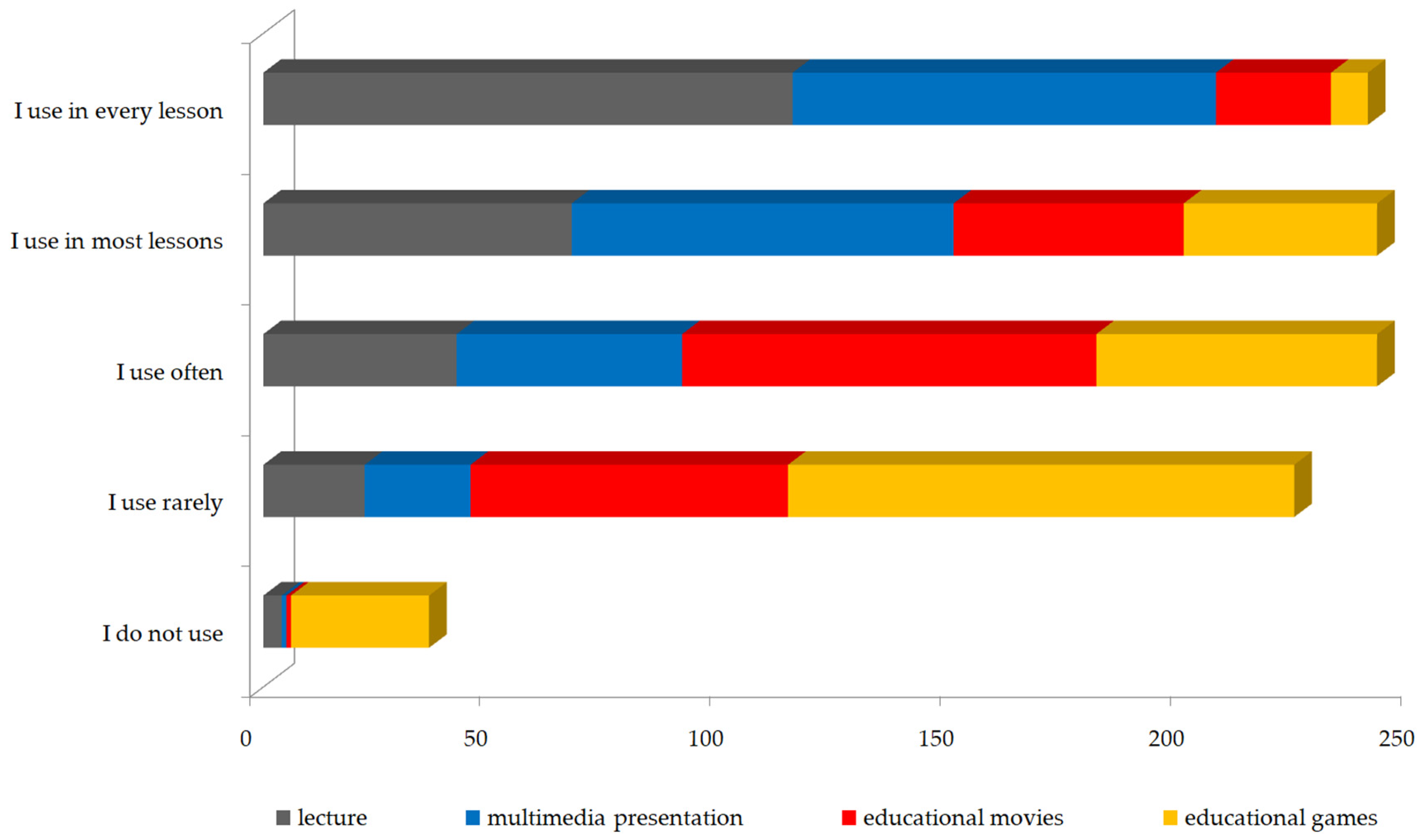
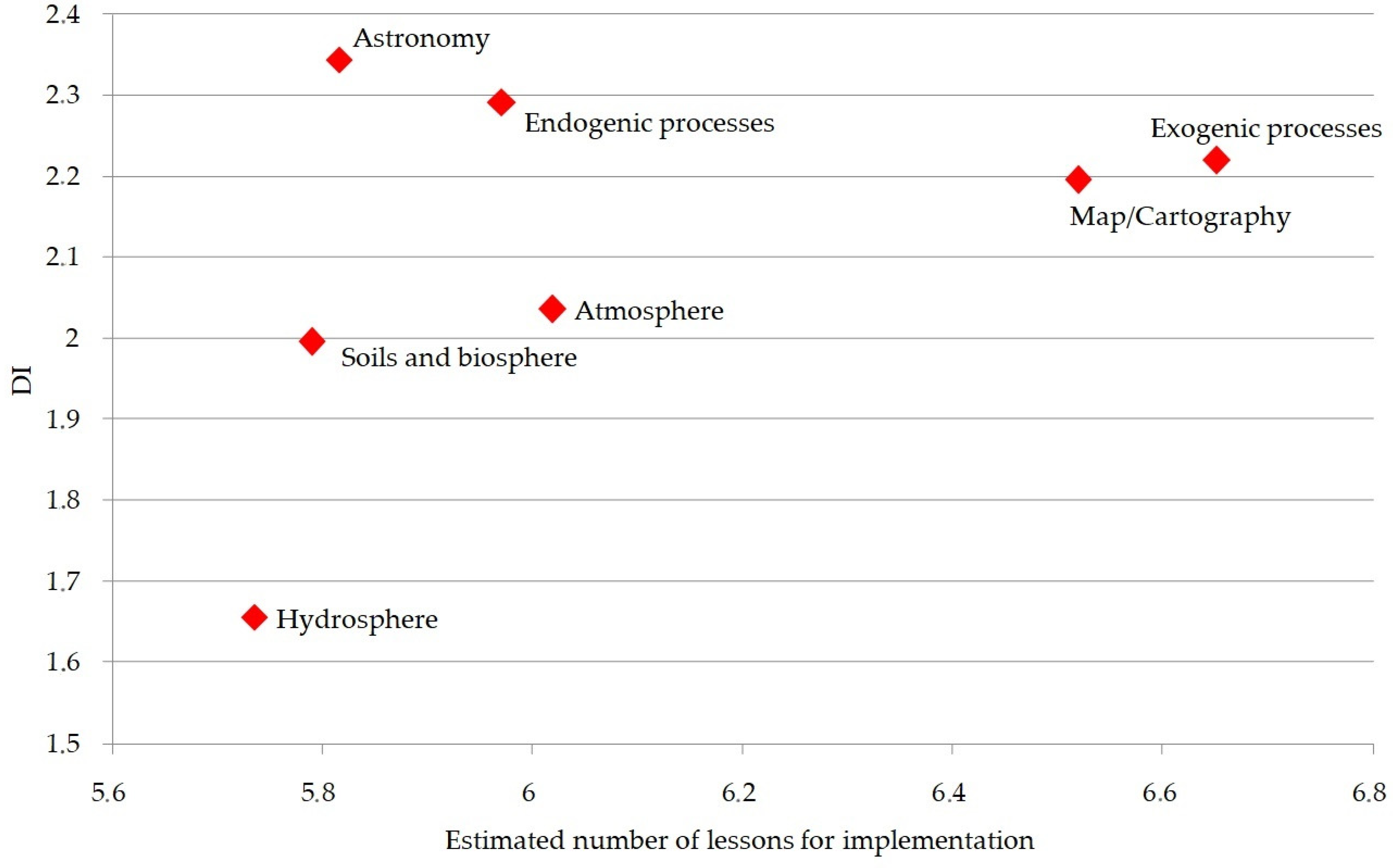
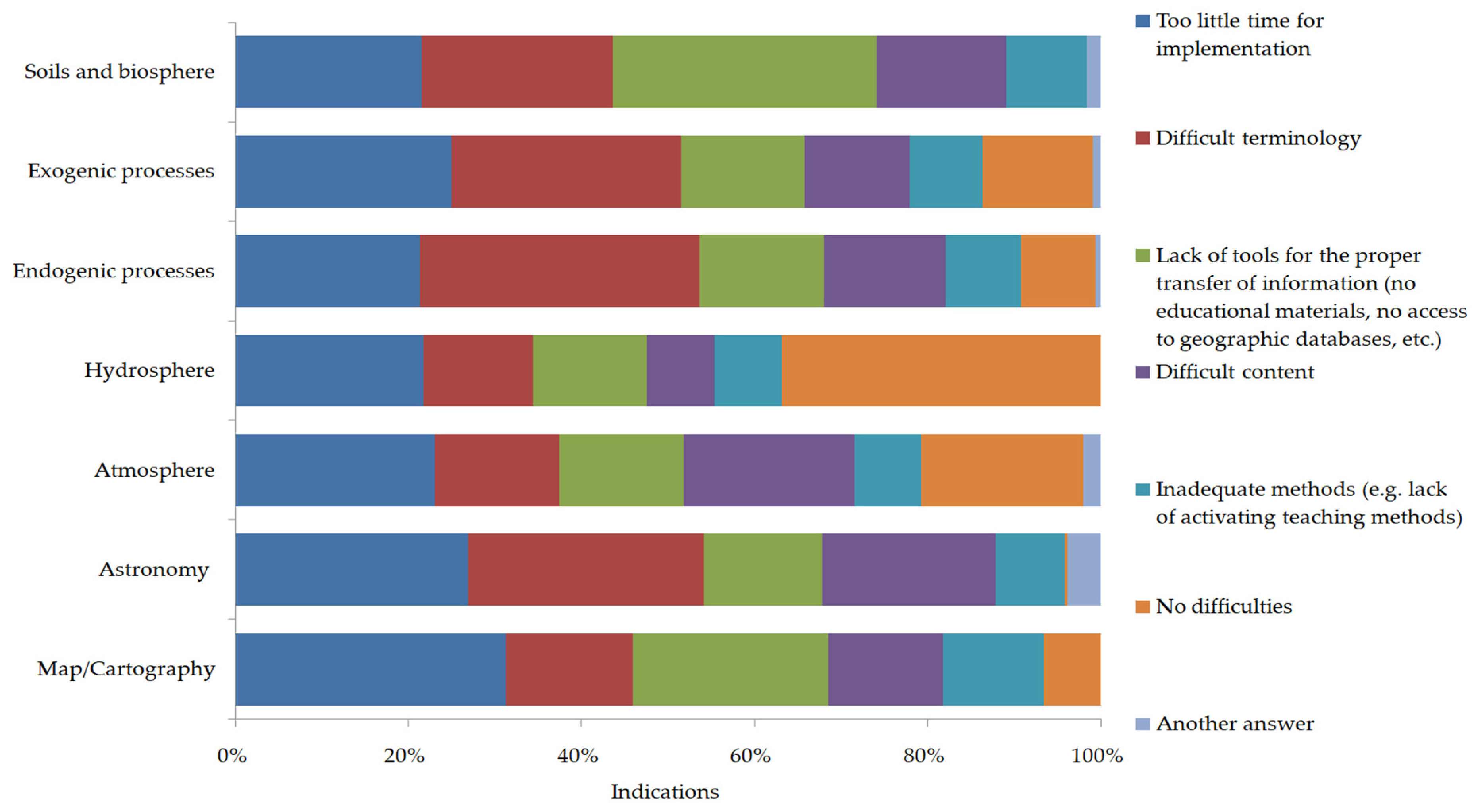

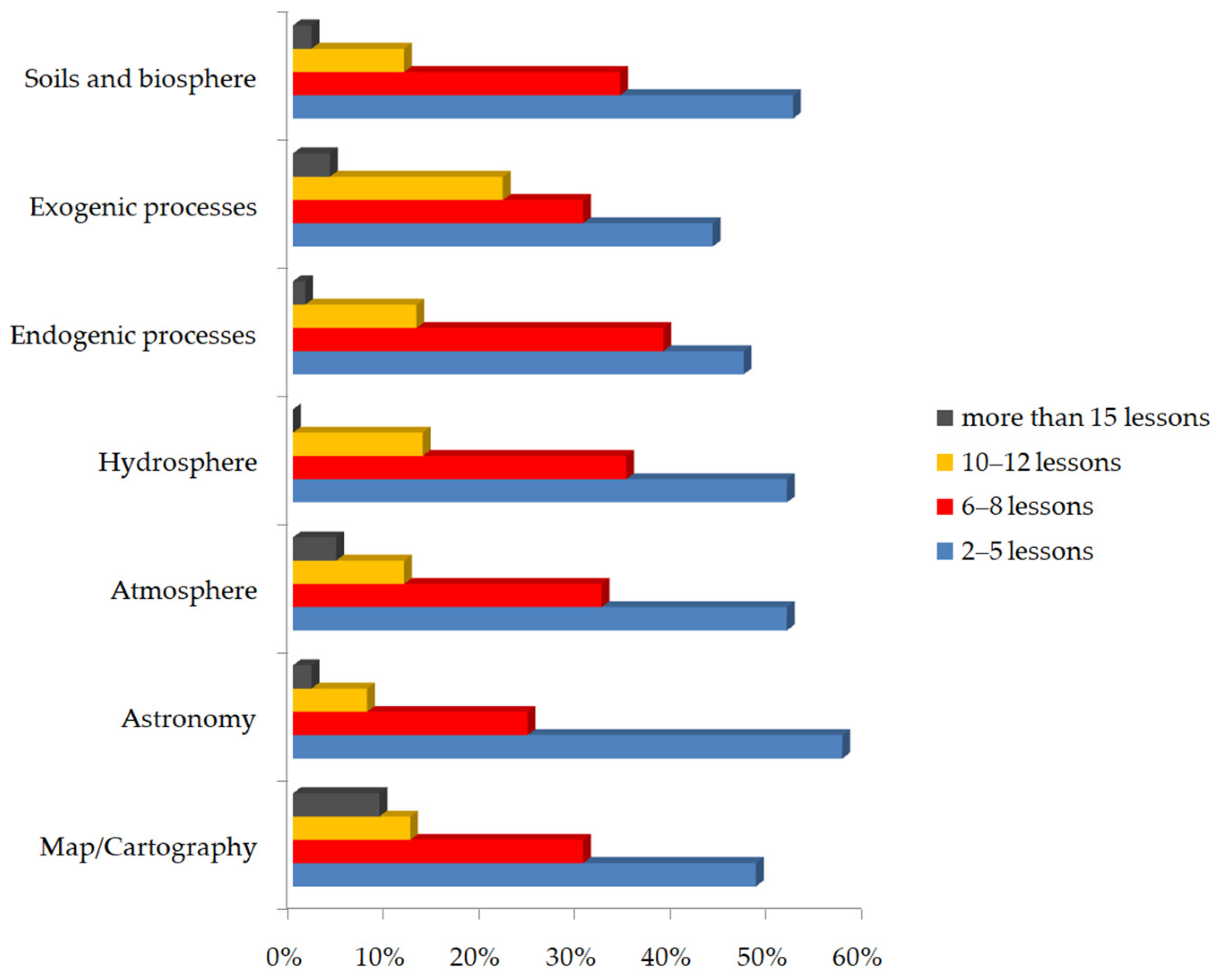
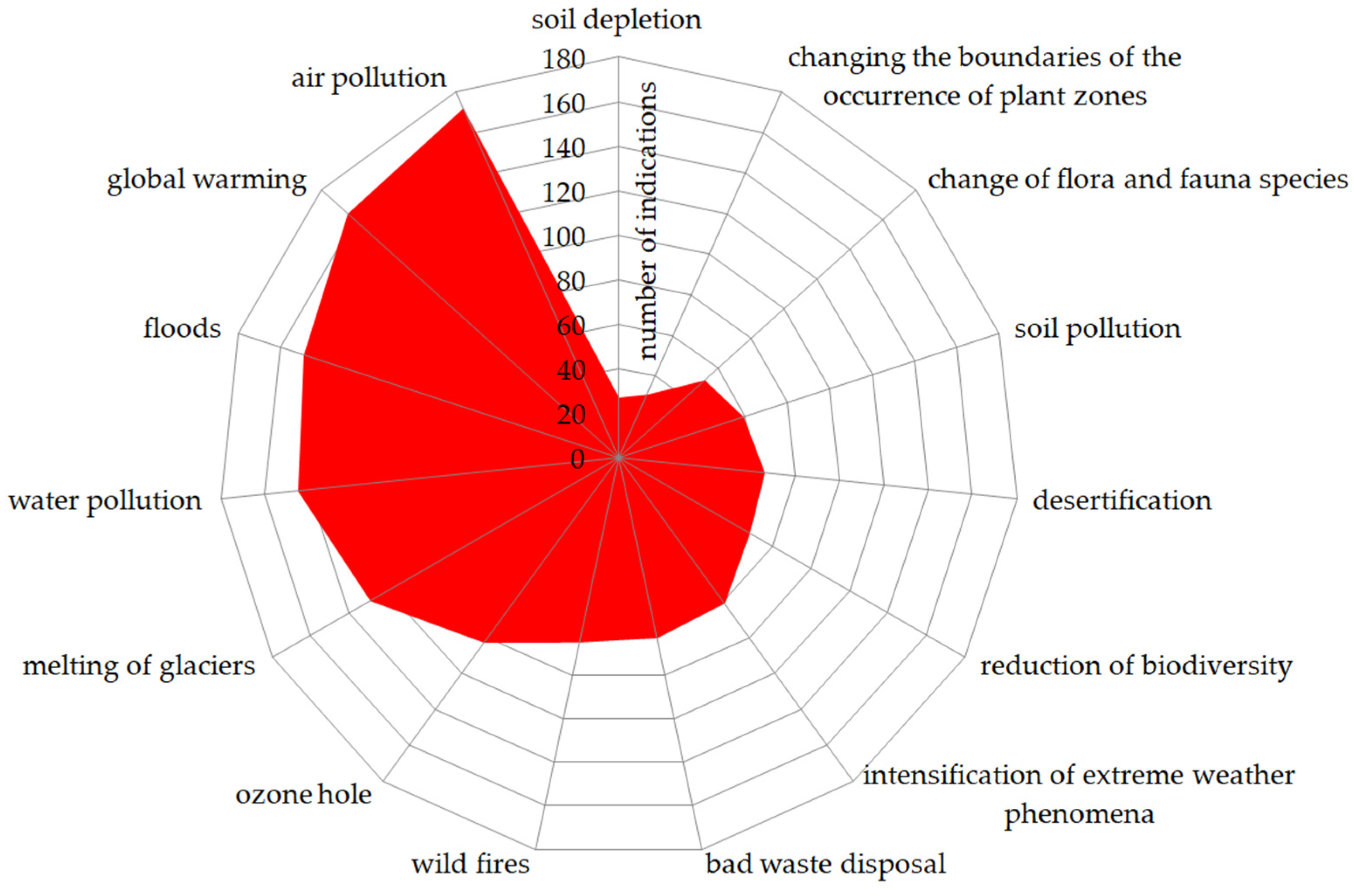


| Sex | % |
| Female | 45 |
| Male | 55 |
| Age | |
| 24–35 | 35 |
| 35–45 | 32 |
| 45–55 | 28 |
| 55–65 | 4 |
| >65 | 1 |
| Seniority at school | |
| 0–5 years | 19 |
| 5–10 years | 16 |
| 10–15 years | 15 |
| 15–20 years | 25 |
| 20–25 years | 16 |
| 25–30 years | 5 |
| 30–35 years | 2 |
| 35–40 years | 2 |
| Type of school | |
| High school | 74 |
| Vocational high school | 8 |
| Artistic (vocal) high school | 1 |
| Other | 17 |
| Self-assessment of the ability to use ICT in geography lessons (1—poor, 5—high) | |
| 1 | 1 |
| 2 | 4 |
| 3 | 20 |
| 4 | 48 |
| 5 | 27 |
| Sex | Number of Indications | % |
|---|---|---|
| Female | 125 | 61 |
| Male | 79 | 39 |
| Sum | 204 | 100 |
| Age | ||
| 15–16 | 158 | 77 |
| 17–18 | 46 | 23 |
| Sum | 204 | 100 |
| Atmosphere | % of Indications |
|---|---|
| air pollution | 28 |
| global warming | 27 |
| ozone hole | 17 |
| wildfires | 14 |
| intensification of extreme weather phenomena | 13 |
| Hydrosphere | |
| floods | 29 |
| water pollution | 29 |
| melting of glaciers | 25 |
| bad waste disposal | 16 |
| Soils and biosphere | |
| reduction of biodiversity | 18 |
| desertification | 17 |
| soil pollution | 14 |
| change of flora and fauna species | 14 |
| changing the boundaries of the occurrence of plant zones | 8 |
| soil depletion | 7 |
| Kruskal–Wallis Test Components | Scores |
|---|---|
| H (chi2) | 10.08 |
| Hc (tie corrected) | 10.11 |
| p (same) | 0.006364 |
| Atmosphere | Hydrosphere | Soils and Biosphere | |
|---|---|---|---|
| Atmosphere | x | 0.9812 | 0.006428 |
| Hydrosphere | 0.9812 | x | 0.01014 |
| Soils and biosphere | 0.006428 | 0.01014 | x |
Publisher’s Note: MDPI stays neutral with regard to jurisdictional claims in published maps and institutional affiliations. |
© 2021 by the authors. Licensee MDPI, Basel, Switzerland. This article is an open access article distributed under the terms and conditions of the Creative Commons Attribution (CC BY) license (https://creativecommons.org/licenses/by/4.0/).
Share and Cite
Urbańska, M.; Charzyński, P.; Gadsby, H.; Novák, T.J.; Şahin, S.; Yilmaz, M.D. Environmental Threats and Geographical Education: Students’ Sustainability Awareness—Evaluation. Educ. Sci. 2022, 12, 1. https://doi.org/10.3390/educsci12010001
Urbańska M, Charzyński P, Gadsby H, Novák TJ, Şahin S, Yilmaz MD. Environmental Threats and Geographical Education: Students’ Sustainability Awareness—Evaluation. Education Sciences. 2022; 12(1):1. https://doi.org/10.3390/educsci12010001
Chicago/Turabian StyleUrbańska, Magdalena, Przemysław Charzyński, Helen Gadsby, Tibor József Novák, Salih Şahin, and Monica Denise Yilmaz. 2022. "Environmental Threats and Geographical Education: Students’ Sustainability Awareness—Evaluation" Education Sciences 12, no. 1: 1. https://doi.org/10.3390/educsci12010001
APA StyleUrbańska, M., Charzyński, P., Gadsby, H., Novák, T. J., Şahin, S., & Yilmaz, M. D. (2022). Environmental Threats and Geographical Education: Students’ Sustainability Awareness—Evaluation. Education Sciences, 12(1), 1. https://doi.org/10.3390/educsci12010001






